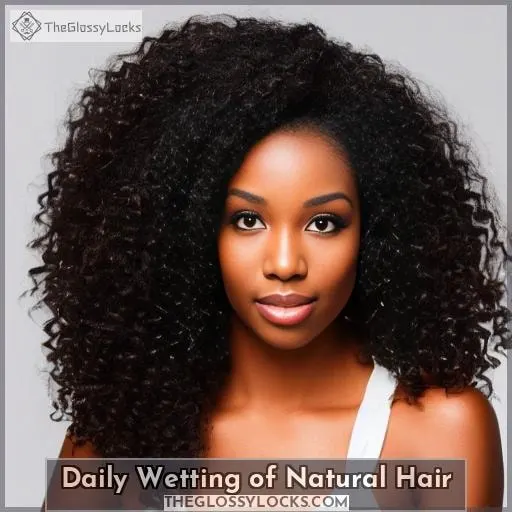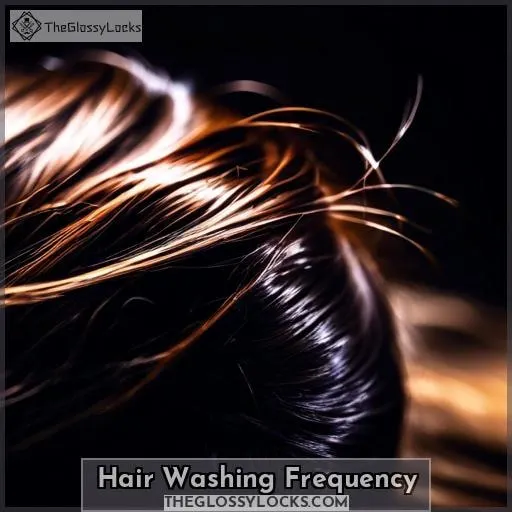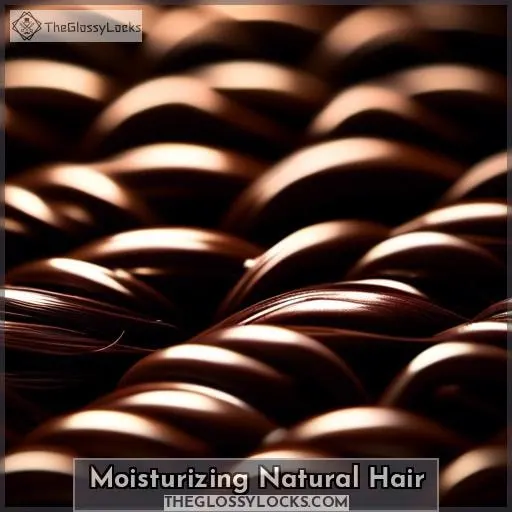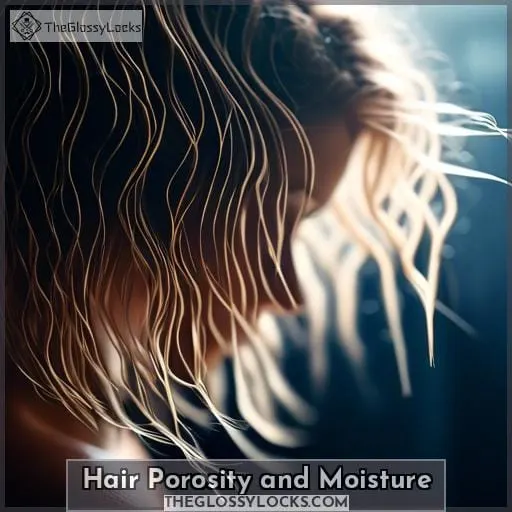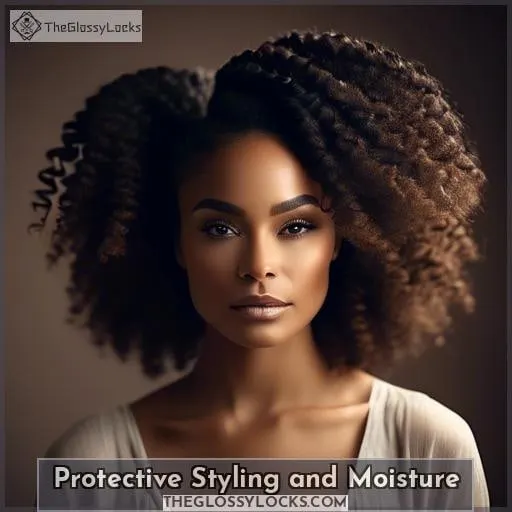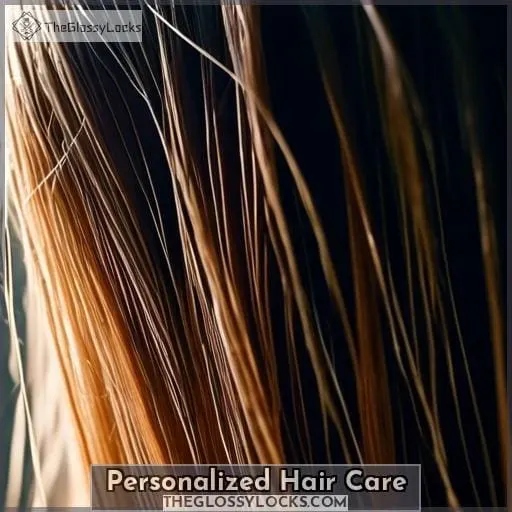This site is supported by our readers. We may earn a commission, at no cost to you, if you purchase through links.

The question of whether to wet natural hair daily taps into this quest, offering both potential benefits and risks. Understanding your hair’s unique needs, including its porosity and how it responds to moisture, is crucial.
This article delves into the art and science of moisturizing natural hair, exploring techniques like the LOC method, and the impact of daily wetting on different hair types. Whether you’re aiming to enhance curl definition, reduce frizz, or simply maintain healthy, vibrant hair, mastering moisture is key to unlocking your hair’s full potential.
No, you should not wet your natural hair every day as it can lead to hygral fatigue, which damages the hair through repeated swelling and drying. Wetting your hair daily can be beneficial in certain situations, such as rinsing away product buildup or after exercising, but it’s not necessary for maintaining moisture.
Table Of Contents
- Key Takeaways
- Daily Wetting of Natural Hair
- Hair Washing Frequency
- Moisturizing Natural Hair
- Hair Porosity and Moisture
- Detangling and Styling
- Protective Styling and Moisture
- Personalized Hair Care
- Frequently Asked Questions (FAQs)
- How does the climate or environment I live in affect the decision to wet my natural hair daily?
- Can wetting my natural hair every day lead to changes in my hair’s texture or curl pattern over time?
- Are there specific ingredients in water (like hard water minerals) that could negatively impact my natural hair when wetting it daily?
- How does the length and thickness of my natural hair influence the effectiveness and consequences of daily wetting?
- What are the long-term effects of daily hair wetting on scalp health, especially concerning natural oil production and potential for irritation or dandruff?
- Conclusion
Key Takeaways
- Wetting natural hair daily can help maintain moisture levels, which is particularly beneficial for dry hair types like 4c, and can aid in styling and detangling, but it should not involve shampooing more than once a week to prevent dryness and product buildup.
- Daily wetting of hair must be balanced with the risk of hygral fatigue, which can damage hair, and product buildup that may clog hair follicles, so it’s important to not overdo it and consider the health of the scalp.
- The LOC method (Liquid, Oil, Cream) is recommended for moisturizing natural hair effectively, and incorporating refresher sprays or leave-in conditioners can help maintain hydration without over-wetting the hair.
- When detangling, wetting the hair can make the process easier, but it’s important to use the right tools, such as a wide-tooth comb or detangling brush, and to apply conditioner or detangling spray to minimize breakage.
Daily Wetting of Natural Hair
Wetting natural hair daily can be beneficial for maintaining moisture, especially for curly or kinky hair types, which are prone to dryness. However, the frequency of washing natural hair with shampoo should be tailored to individual needs, as over-washing can strip the hair of its natural oils, leading to dryness and potential scalp issues.
While some sources suggest washing natural hair about once a week, others indicate that the optimal frequency can vary based on lifestyle, hair type, and personal preference. It’s important to use gentle, hydrating products and techniques when wetting and washing natural hair to preserve its health and moisture balance.
For detangling and styling, it’s recommended to use a spray bottle with water and hydrating ingredients like coconut oil or rose water, and to detangle with fingers or a wide-tooth comb when the hair is wet.
After washing, applying a moisturizing conditioner or oil can help restore moisture. If hair tangles after wetting, it may indicate dryness, and using a moisturizing conditioner or oil can help boost moisture and detangle.
Daily wetting of natural hair without shampoo can be part of a moisturizing routine, but it’s important to be aware of the potential for hygral fatigue, which occurs when hair swells and contracts from excessive moisture, leading to damage.
Adjusting the routine based on hair porosity and individual needs is crucial, and protective measures like using a satin bonnet at night can help maintain hair moisture.
In summary, while daily wetting can help with hydration and styling, it’s essential to balance this with proper hair care to avoid over-moisturizing and potential damage. Consulting with a stylist can provide personalized advice on the best routine for your natural hair.
Benefits of Daily Wetting
Wetting your natural hair daily can be a refreshing ritual that brings a handful of benefits:
- Hydration Boost: Like a thirsty plant soaking up rain, your hair absorbs moisture from water, which can be especially beneficial for 4c hair that tends to be drier.
- Curl Revival: Imagine your curls as sleepy morning flowers; a daily sprinkle can help them perk up and regain their shape after a night’s rest.
- Detangling Ease: With water as a natural lubricant, knots can be teased out more gently, preserving your hair’s integrity.
- Scalp Health: Keeping the scalp hydrated without stripping away natural oils can be like a soothing balm, maintaining a healthy foundation for hair growth.
Risks of Daily Wetting
Wetting your natural hair daily can feel like a refreshing splash of hydration, but it’s not all sunshine and rainbows.
- Hygral Fatigue: Imagine your hair throwing up a white flag. Too much moisture can lead to hygral fatigue, where your hair cuticles swell and contract so much they start to wear out, leaving your locks more vulnerable to breakage.
- Product Buildup: Layering on products day after day without a proper cleanse can lead to congested hair follicles. This not only dulls your shine but could also hamper healthy hair growth.
- Dry Natural Hair Paradox: Ironically, soaking your mane daily can strip away natural oils, leading to drier hair over time. It’s like taking one step forward and two steps back in your moisturizing quest.
- Cellular Turnover & Scalp Health: Constant wetting without allowing your scalp to breathe can mess with the natural cellular turnover, potentially leading to an oily yet dry, unhappy scalp situation.
So, while a daily sprinkle might seem like a shortcut to hydration heaven, it’s more about finding that sweet spot. Too much of a good thing can lead your hair down a slippery slope to Drysville and Breakage Borough.
Hair Washing Frequency
When considering the frequency of wetting or washing natural hair, it’s essential to understand that natural hair’s unique texture and needs dictate a specialized approach.
You can wet your natural hair daily to maintain moisture, but this doesn’t mean shampooing it each time. Daily wetting, through rinsing or spritzing with water, helps keep the hair hydrated and manageable without stripping it of its natural oils.
However, shampooing should be limited to about once a week to prevent drying out the hair and scalp. This regimen supports the hair’s natural moisture balance, ensuring that curls remain defined and healthy.
General Guidelines
Continuing from the benefits of daily wetting, let’s dive into the general guidelines for hair washing frequency. Your natural hair’s washing schedule isn’t one-size-fits-all; it’s a delicate balance that depends on several factors.
- Hydration Balance: Aim to maintain moisture without overdoing it. Over-wetting can lead to damage, so find a rhythm that keeps your hair hydrated but not saturated.
- Product Buildup: Shampooing helps remove buildup, but too much can strip natural oils. Use a gentle, water-based moisturizer to keep hair clean and conditioned.
- Hair Breakage: Wet hair is vulnerable; avoid breakage by minimizing manipulation when wet and using a daily moisturizer to strengthen strands.
- Cleansing Needs: Listen to your hair. Some may need to cleanse more often due to lifestyle or scalp health, while others can go longer between washes with just a spritz of water or dry shampoo.
Thinning Hair Considerations
Continuing from the general guidelines on hair washing frequency, let’s delve into the specific considerations for those with thinning hair.
- Aging Hair: As hair matures, it may become thinner and more fragile, necessitating a gentle touch and possibly more frequent cleansing to stimulate the scalp and prevent buildup.
- Protein Treatments: Incorporate protein treatments into your routine to reinforce hair strength, but be mindful not to overdo it as too much protein can lead to brittleness.
- Denman Brush: Utilize tools like the Denman brush in conjunction with dry shampoo to refresh your scalp and hair without over-washing, which can help maintain scalp health.
- Dry Shampoo: On days when you skip the water, dry shampoo can be a savior for absorbing excess oil and giving your hair a cleaner appearance without stripping it of its natural oils.
Moisturizing Natural Hair
When it comes to moisturizing natural hair, understanding and applying the right techniques can significantly enhance the health and appearance of your curls.
The LOC method, standing for Liquid, Oil, and Cream, is a holistic and scientific approach to ensuring your hair retains moisture effectively. By layering these products in the specified order, you’re able to lock in hydration, providing a foundation for well-defined, vibrant, and nourished curls.
Moisturizing Techniques
Continuing from the importance of finding the right hair washing frequency, let’s dive into moisturizing techniques that will keep your natural hair in tip-top shape. Remember, your daily routine should cater to your hair’s unique needs, especially when it comes to hydration.
- Refresher Sprays: Use them daily to rehydrate your curls and braids, ensuring your hair stays lively and well-moisturized.
- Leave-in Conditioners: These are your best friends for locking in moisture post-wash and keeping your hair soft and manageable.
- LOC Method: A systematic approach to layering moisturizing products—liquid, oil, and cream—to maximize moisture retention.
- Hair Porosity Consideration: Tailor your moisturizing products to your hair’s porosity for optimal hydration and health.
By incorporating these techniques, you’ll be well on your way to mastering the art of moisture, giving your hair the freedom to flourish and you the mastery over your hair care routine.
LOC Method
Continuing from the discussion on moisturizing techniques, let’s delve into the LOC method, a specialized, holistic approach to keeping your natural hair well-hydrated. Understanding your hair porosity is crucial here, as it influences how well your hair can absorb and retain moisture.
- Leave-in Conditioner: Apply a water-based leave-in to clean, damp hair to introduce moisture.
- Oil Sealing: Follow with an oil to seal in the moisture; consider your hair’s porosity to choose the right oil.
- Cream Sealing: Finish with a cream to lock everything in, ensuring your hair stays hydrated longer.
This method is a game-changer, especially for high porosity hair that tends to lose moisture as quickly as a sieve loses water. It’s like giving your thirsty curls a long, satisfying drink, and who wouldn’t want that? Remember, the goal is freedom from dryness, not a greasy oil slick, so adjust the amounts to what your hair truly needs.
Hair Porosity and Moisture
Understanding your hair’s porosity is crucial for maintaining its moisture balance.
High porosity hair, characterized by more widely spaced cuticles, can absorb moisture quickly but struggles to retain it, leading to dryness and tangling.
To manage this, you should incorporate protein-rich products into your routine to strengthen and hydrate your strands.
Understanding Porosity
Continuing from the importance of moisturizing your natural hair, let’s dive into the science of hair porosity.
- Low Porosity Hair: Resists moisture and product absorption, making it challenging to hydrate but once moisturized, it retains it well.
- Medium Porosity Hair: Allows for easier moisture absorption and retention, striking a balance that most hair care products cater to.
- High Porosity Hair: Absorbs moisture quickly but struggles to retain it, often due to damage or genetics, necessitating protein-rich products for strength and hydration.
Knowing your porosity level is like holding the master key to unlocking the full potential of your hair care routine. It’s not just about slathering on products; it’s about choosing the right ones that your hair will actually take in and hold onto.
Imagine trying to fill a sieve with water—that’s high porosity hair without the right support. Conversely, low porosity hair can be like a sealed drum, barely letting any moisture in. Porosity testing can guide you to the right products, whether it’s a lightweight hydrator for low porosity or a protein-packed powerhouse for those thirsty high porosity strands.
High Porosity Hair Care
Continuing from the discussion on understanding hair porosity, let’s dive into the care for high porosity hair. If you’ve got high porosity locks, you’re in a unique league where moisture retention is akin to trying to hold water in a sieve.
But fear not, with the right tactics, you can turn the tide and keep those strands quenched.
- Porosity testing: Know thy hair! A simple float test can reveal your porosity status.
- Moisture retention: It’s all about layering—think of your hair as a lasagna needing layers of moisture.
- Protein treatments: These are the reinforcements that fill in the gaps like grout between tiles.
- Deep conditioning: Consider this your hair’s spa day, a must for keeping it supple and strong.
Detangling and Styling
When considering whether to wet natural hair daily, it’s important to understand the implications for detangling and styling.
Wetting your hair can make it easier to detangle, especially when using a wide-tooth comb or your fingers.
However, it’s crucial to use the right products that align with your hair’s porosity to avoid causing dryness or excessive tangling. For high porosity hair, which tends to lose moisture quickly, using protein-rich products can help retain hydration.
Detangling When Wet
Detangling when wet is akin to navigating a labyrinth; it requires patience, the right tools, and a bit of know-how.
- Choose Your Weapon Wisely: Opt for a wide-tooth comb or a specialized detangling brush. These tools are gentle on your curls and help prevent breakage.
- Moisture is Your Best Friend: Apply a generous amount of conditioner or a detangling spray. This creates slip, making it easier for your comb or brush to glide through your hair.
- Section and Conquer: Divide your hair into manageable sections. This not only makes the task less daunting but ensures you’re thorough, leaving no strand behind.
- Start from the Bottom: Always begin detangling from the ends and work your way up to the roots. This technique minimizes pain and reduces hair breakage.
Styling After Wetting
After wetting your hair, it’s prime time to style it to perfection. Here’s how to make every strand count:
Choose Your Products Wisely: Opt for product recommendations that cater to your hair’s needs. Whether it’s for hydration in dry climates or for heat styling on special occasions, the right products can make or break your look. Consider lightweight leave-ins for a bouncy feel or heavier creams for more definition.
Embrace Your Length: Hair length plays a crucial role in styling. Longer tresses might enjoy the freedom of twists and braids, while shorter cuts can rock wash-and-gos with ease. Don’t shy away from experimenting with styles that highlight the best of your hair’s length.
Prep for the Big Days: Special occasions call for that extra oomph. Whether it’s a silk press for a sleek look or a twist-out for voluminous curls, starting with damp hair allows for better product penetration and a more defined outcome. Remember, a little prep goes a long way in achieving that head-turning style.
By keeping these tips in mind, you’ll not only protect your hair’s health but also step out in style, no matter the occasion or climate.
Protective Styling and Moisture
When considering the daily wetting of natural hair, especially in the context of protective styling and moisture, it’s crucial to understand the balance between hydration and potential over-manipulation.
Wetting your hair daily can be a double-edged sword; it provides essential moisture that’s the lifeline for healthy, natural hair but can also lead to increased manipulation, which might stress your strands.
For those with protective styles, such as braids or twists, a light misting to introduce moisture without fully saturating the hair might be beneficial. This approach allows you to maintain the protective style’s integrity while ensuring your hair and scalp remain hydrated.
Moisturizing Protective Styles
When it comes to moisturizing protective styles, it’s crucial to keep your braids and twists hydrated without causing buildup or frizz.
- Mist your braids with a refresher spray to keep them lively and hydrated.
- Apply oils to the scalp using a dropper for targeted nourishment.
- Wrap your hair in a satin bonnet at night to reduce friction and preserve moisture.
- Embrace the benefits of a satin bonnet, which helps maintain hair hydration and prevent tangling.
Nighttime Hair Care
Nighttime is when your hair gets a chance to rest and rejuvenate, just like you do.
- Wrap It Up: Tuck your tresses into a satin or silk bonnet before bed. These smooth materials are like a gentle hug for your hair, keeping moisture locked in and breakage at bay.
- Seal the Deal: Apply a light oil or serum to seal in the moisture. Think of it as tucking your hair in with a cozy blanket that keeps the hydration from escaping into the night.
- Stay Loose: Avoid tight hairstyles that could stress your strands. A loose braid or pineapple can keep curls defined without the tension, so you can say good morning to a good hair day.
Personalized Hair Care
When considering whether to wet natural hair every day, it’s essential to consult with a stylist and experiment to find what works best for your unique hair needs.
A stylist can provide personalized advice based on your hair’s characteristics and lifestyle factors. Experimentation can help you determine the right balance of moisture for your hair, taking into account factors like hair porosity and the specific products that work well for you.
Consulting a Stylist
After exploring the ins and outs of moisturizing and protective styling, it’s time to dive into the world of personalized hair care through stylist consultation.
- Hair Type Assessment: A stylist can pinpoint your hair’s unique characteristics—be it curl pattern, porosity, or texture. This insight is crucial for tailoring your hair care routine to your specific needs.
- Product Recommendations: Ever feel lost in the sea of hair products? A stylist can navigate these waters with you, recommending products that will work wonders for your hair type, without the trial and error.
- Hair Analysis: Beyond just looking at your hair, some stylists offer detailed hair analysis services. This scientific approach can reveal what your hair is truly craving, from moisture to protein, and everything in between.
Experimentation
After consulting with a stylist, you’ll have a solid foundation for your hair care routine. But don’t forget, the true magic happens when you start experimenting with your own locks. Your hair’s unique porosity, texture, and needs mean that a one-size-fits-all approach just won’t cut it.
- Test different moisturizing techniques to see what quenches your hair’s thirst.
- Try various detangling methods to find your hair’s happy place.
- Explore protective styling options to shield your mane while looking chic.
Frequently Asked Questions (FAQs)
How does the climate or environment I live in affect the decision to wet my natural hair daily?
In humid climates, daily wetting may lead to frizz and tangling. Arid environments can cause dryness, making frequent hydration necessary.
Your locale’s weather patterns should guide your hair’s moisture needs. Keep it breezy, and let your hair’s thirst be quenched by the climate’s cue.
Can wetting my natural hair every day lead to changes in my hair’s texture or curl pattern over time?
Wetting your natural hair daily can indeed lead to changes in your hair’s texture or curl pattern over time, primarily due to a phenomenon known as hygral fatigue.
Hygral fatigue occurs when hair fibers swell and contract with each wetting and drying cycle, which can weaken the hair over time, leading to changes in texture and curl pattern. This is especially true if the hair is manipulated while wet, as it’s more fragile and prone to damage in this state.
Additionally, frequent wetting without proper moisturization can strip the hair of its natural oils, leading to dryness and further affecting its texture and pattern. To mitigate these effects, it’s crucial to balance wetting with adequate conditioning and to use techniques that minimize damage, such as gentle detangling and protective styling.
Are there specific ingredients in water (like hard water minerals) that could negatively impact my natural hair when wetting it daily?
Like a fish out of water, your natural hair might not thrive with daily drenching if your tap is a hard water haven. Rich in minerals like calcium and magnesium, it can build up and dull your mane.
How does the length and thickness of my natural hair influence the effectiveness and consequences of daily wetting?
The length and thickness of your natural hair play a crucial role in how it responds to daily wetting.
Thicker, longer hair might retain moisture better but could also take longer to dry, potentially leading to issues like mildew if not properly cared for.
Conversely, shorter, finer hair might dry quickly but could become over-hydrated or lose essential oils more rapidly, leading to increased fragility and breakage.
Essentially, the denser and longer your mane, the more you’ll need to balance hydration with ensuring it fully dries to maintain hair health.
What are the long-term effects of daily hair wetting on scalp health, especially concerning natural oil production and potential for irritation or dandruff?
Diving headfirst into the sea of daily hair wetting, think of your scalp as a garden that thrives on balance.
Over-watering can wash away the soil’s natural nutrients. Similarly, daily wetting may strip your scalp of its natural oils, leading to a dry, itchy battleground and potentially dandruff.
However, like a well-tended garden, the right amount of hydration can prevent oil overproduction and keep the scalp’s ecosystem in harmony, reducing irritation and promoting healthier hair growth.
Conclusion
With over 100,000 strands on an average head, each capable of supporting 6.5 pounds, your hair is a marvel of strength and resilience.
Yet, when considering whether you should wet your natural hair every day, it’s essential to recognize that its robustness doesn’t equate to invulnerability.
Instead, focus on tailored moisturizing strategies like the LOC method, and understand your hair’s porosity for optimal care.

